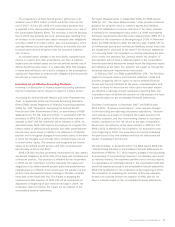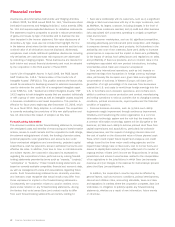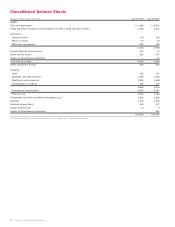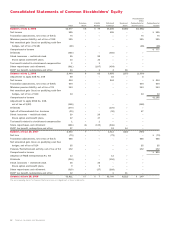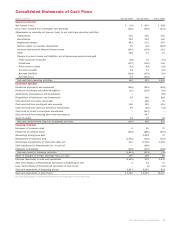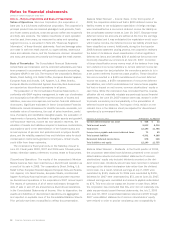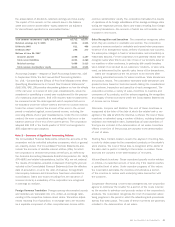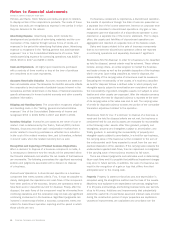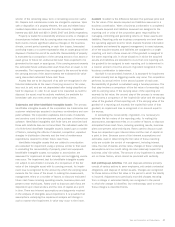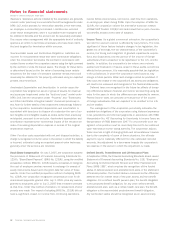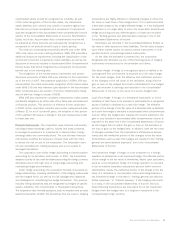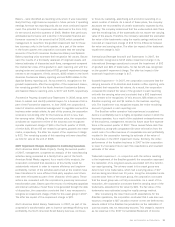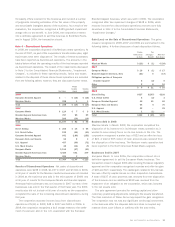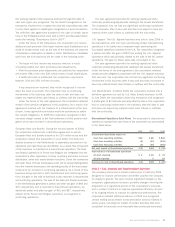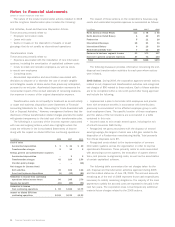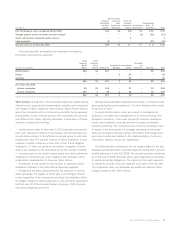Sara Lee 2008 Annual Report Download - page 49
Download and view the complete annual report
Please find page 49 of the 2008 Sara Lee annual report below. You can navigate through the pages in the report by either clicking on the pages listed below, or by using the keyword search tool below to find specific information within the annual report.shorter of the remaining lease term or remaining economic useful
life. Repairs and maintenance costs are charged to expense. Upon
sale or disposition of a property element, the cost and related accu-
mulated depreciation are removed from the accounts. Capitalized
interest was $18, $20 and $20 in 2008, 2007 and 2006, respectively.
Property is tested for recoverability whenever events or changes in
circumstances indicate that its carrying value may not be recoverable.
Such events include significant adverse changes in the business
climate, current period operating or cash flow losses, forecasted
continuing losses or a current expectation that an asset group will be
disposed of before the end of its useful life. Recoverability of property
is evaluated by a comparison of the carrying amount of an asset or
asset group to future net undiscounted cash flows expected to be
generated by the asset or asset group. If the carrying amount exceeds
the estimated future undiscounted cash flows then an asset is not
recoverable. The impairment loss recognized is the amount by which
the carrying amount of the asset exceeds the estimated fair value
using discounted estimated future cash flows.
Assets that are to be disposed of by sale are recognized in the
financial statements at the lower of carrying amount or fair value,
less cost to sell, and are not depreciated after being classified as
held for disposal. In order for an asset to be classified as held for
disposal, the asset must be actively marketed, be available for
immediate sale and meet certain other specified criteria.
Trademarks and Other Identifiable Intangible Assets The primary
identifiable intangible assets of the corporation are trademarks and
customer relationships acquired in business combinations and com-
puter software. The corporation capitalizes direct costs of materials
and services used in the development and purchase of internal-use
software. Identifiable intangibles with finite lives are amortized and
those with indefinite lives are not amortized. The estimated useful life
of a finite-lived identifiable intangible asset is based upon a number
of factors, including the effects of demand, competition, expected
changes in distribution channels and the level of maintenance
expenditures required to obtain future cash flows.
Identifiable intangible assets that are subject to amortization
are evaluated for impairment using a process similar to that used
in evaluating the recoverability of property, plant and equipment.
Identifiable intangible assets not subject to amortization are
assessed for impairment at least annually and as triggering events
may occur. The impairment test for identifiable intangible assets
not subject to amortization consists of a comparison of the fair
value of the intangible asset with its carrying amount. An impair-
ment loss is recognized for the amount by which the carrying value
exceeds the fair value of the asset. In making this assessment,
management relies on a number of factors to discount estimated
future cash flows including operating results, business plans and
present value techniques. Rates used to discount cash flows are
dependent upon interest rates and the cost of capital at a point
in time. There are inherent assumptions and judgments required
in the analysis of intangible asset impairment. It is possible that
assumptions underlying the impairment analysis will change in
such a manner that impairment in value may occur in the future.
Goodwill Goodwill is the difference between the purchase price and
the fair value of the assets acquired and liabilities assumed in a
business combination. When a business combination is completed,
the assets acquired and liabilities assumed are assigned to the
reporting unit or units of the corporation given responsibility for
managing, controlling and generating returns on these assets and
liabilities. Reporting units are business components one level below
the operating segment level for which discrete financial information
is available and reviewed by segment management. In many instances,
all of the acquired assets and liabilities are assigned to a single
reporting unit and in these cases all of the goodwill is assigned to
the same reporting unit. In those situations in which the acquired
assets and liabilities are allocated to more than one reporting unit,
the goodwill to be assigned to each reporting unit is determined in
a manner similar to how the amount of goodwill recognized in the
business combination is determined.
Goodwill is not amortized; however, it is assessed for impairment
at least annually and as triggering events may occur. The corporation
performs its annual review in the second quarter of each year.
Recoverability of goodwill is evaluated using a two-step process. The
first step involves a comparison of the fair value of a reporting unit
with its carrying value. If the carrying value of the reporting unit
exceeds its fair value, the second step of the process is necessary
and involves a comparison of the implied fair value and the carrying
value of the goodwill of that reporting unit. If the carrying value of the
goodwill of a reporting unit exceeds the implied fair value of that
goodwill, an impairment loss is recognized in an amount equal to
the excess.
In evaluating the recoverability of goodwill, it is necessary to
estimate the fair values of the reporting units. In making this
assessment, management relies on a number of factors to discount
anticipated future cash flows, including operating results, business
plans and present value techniques. Rates used to discount cash
flows are dependent upon interest rates and the cost of capital at
a point in time. Because some of the inherent assumptions and
estimates used in determining the fair value of these reporting
units are outside the control of management, including interest
rates, the cost of capital, and tax rates, changes in these underlying
assumptions and our credit rating can also adversely impact the
business units’ fair values. The amount of any impairment is depend-
ent on these factors, which cannot be predicted with certainty.
Exit and Disposal Activities Exit and disposal activities primarily
consist of various actions to sever employees, exit certain contractual
obligations and dispose of certain assets. Charges are recognized
for these actions at their fair value in the period in which the liability
is incurred. Adjustments to previously recorded charges resulting
from a change in estimated liability are recognized in the period
in which the change is identified. Our methodology used to record
these charges is described below.
Sara Lee Corporation and Subsidiaries 47


